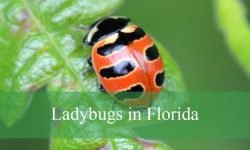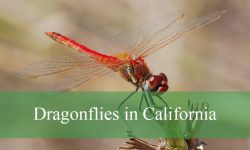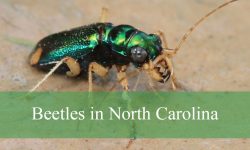New Jersey hosts a diverse range of bird species, and among them, Yellow Birds in New Jersey are especially vibrant and easy to spot. Their bright yellow plumage makes them stand out in forests, wetlands, and backyards across the state.
Identifying Yellow Birds in New Jersey can be both fun and rewarding. Each bird has unique features and behaviors, and this guide provides clear pictures and detailed descriptions to help you recognize these beautiful species with confidence.
This list of Yellow Birds in New Jersey covers 21 common and rare birds you might encounter during different seasons. From the lively American Goldfinch to the rare Prothonotary Warbler, get ready to discover and appreciate the colorful birdlife that New Jersey offers.
Common Yellow Birds Found in New Jersey
American Goldfinch (Spinus tristis)
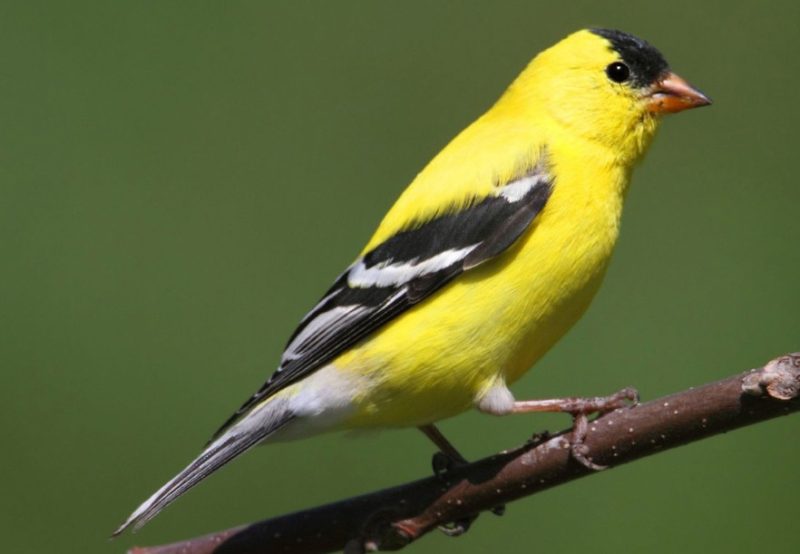
The American Goldfinch is a small, vibrant songbird known for its striking summer plumage. Males are a brilliant lemon-yellow with bold black wings and a black forehead, paired with a conical orange bill. In winter, both sexes turn a muted olive-brown, making them harder to recognize.
This species is found year-round across New Jersey, from suburban gardens to meadows and open woodlands. It is particularly fond of weedy fields and areas with thistles, sunflowers, and other seed-bearing plants. Goldfinches are highly acrobatic, often seen hanging upside-down while feeding.
American Goldfinches primarily eat seeds, especially nyjer (thistle) and sunflower seeds. They are late breeders, nesting in mid-to-late summer to match peak seed availability. Their undulating flight and cheerful calls—like “per-chik-o-ree”—make them a familiar presence in New Jersey’s backyards and fields.
Yellow Warbler (Setophaga petechia)
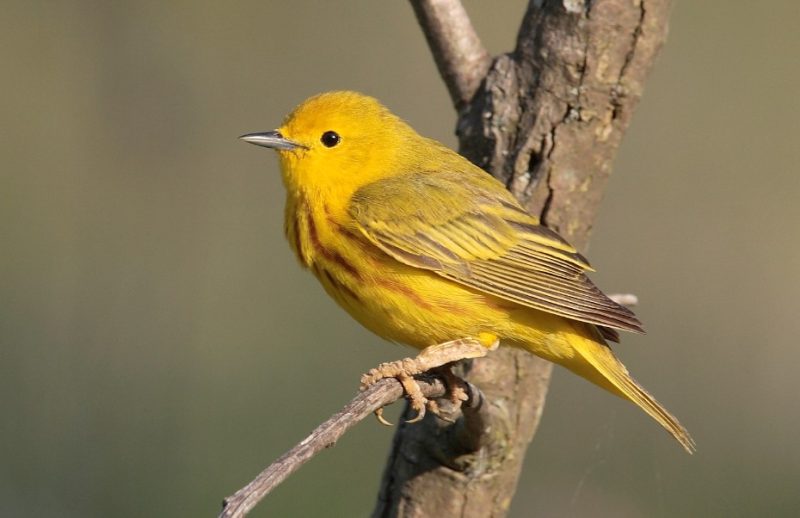
The Yellow Warbler is one of the brightest and most uniformly yellow songbirds in North America. Adult males are entirely golden-yellow with distinct reddish streaks across their chest, while females and immatures are plainer but still yellow throughout. Their rounded heads and black eyes give them a gentle expression.
In New Jersey, Yellow Warblers are common during spring and summer, especially near streams, wetlands, and shrubby areas. They favor willow thickets, wet meadows, and the edges of wooded swamps where insect life is abundant. Their sweet, whistled song—“sweet-sweet-sweet, I’m so sweet!”—is easy to recognize.
This warbler feeds mainly on insects such as caterpillars, beetles, and midges, which it gleans from leaves and twigs. Yellow Warblers migrate to Central and South America in fall and return north in spring to breed. They are especially active during the nesting season and are known for defending their territories fiercely.
Yellow-rumped Warbler (Setophaga coronata)
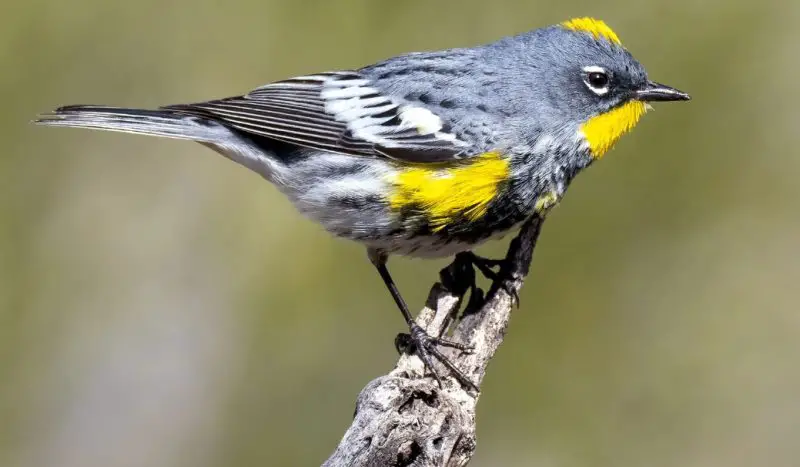
The Yellow-rumped Warbler is a medium-sized warbler with a grayish back, white throat, and distinctive yellow patches on the rump, sides, and crown. These colorful highlights are most noticeable during spring and fall migration, though they persist even in winter plumage.
In New Jersey, Yellow-rumped Warblers are primarily seen in fall, winter, and early spring. They frequent coastal areas, mixed woodlands, and residential parks during migration, and they’re among the few warblers to winter in the state. Their adaptability and diet allow them to survive in colder months.
Unlike most warblers, Yellow-rumped Warblers can digest waxes found in bayberries and wax myrtles, which gives them a unique winter food source. They also eat insects when available. Their sharp “check” call and busy foraging behavior—often flicking their tails—help birdwatchers spot them even in dense foliage.
Yellow-breasted Chat (Icteria virens)
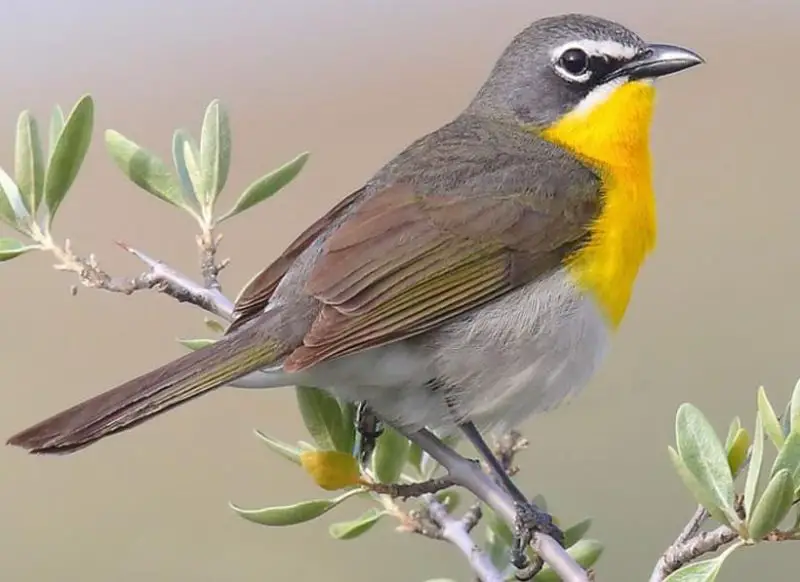
The Yellow-breasted Chat is the largest and most robust of the wood warblers, easily identified by its bright yellow chest, olive-green back, and bold white eye markings. Its heavy bill and long tail give it a distinctive appearance unlike any other warbler.
In New Jersey, this species is uncommon and considered rare, but it does appear during the spring and summer breeding season. Yellow-breasted Chats prefer dense thickets, regenerating forests, and overgrown fields, especially those near wetlands or stream corridors.
They feed on insects, berries, and spiders, often foraging deep in cover and staying hidden. Despite their secretive nature, males are vocal during the breeding season, producing an odd mix of whistles, squawks, and chatters. They are most often detected by sound before being seen.
Prothonotary Warbler (Protonotaria citrea)
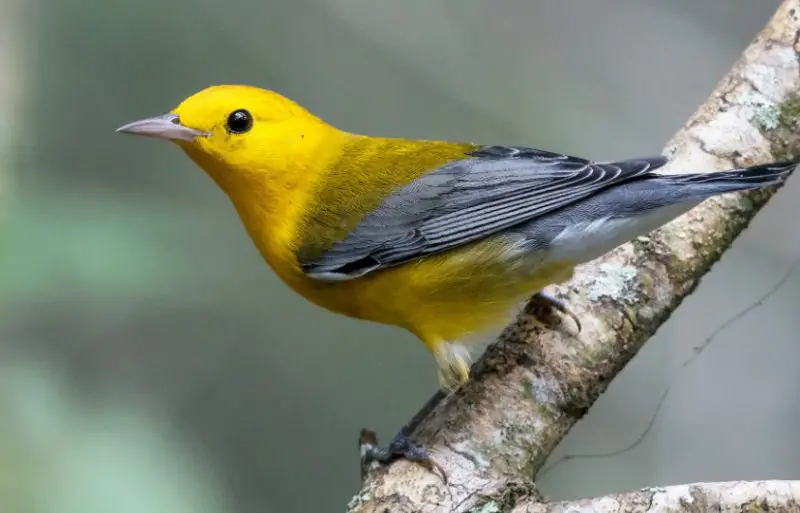
The Prothonotary Warbler is a striking bird with a glowing golden-yellow head and underparts, contrasted by bluish-gray wings and tail. Its large black eyes and short tail make it easy to distinguish when spotted. It is one of the few warblers that nests in tree cavities near water.
In New Jersey, Prothonotary Warblers are rare visitors, but they can occasionally be found during spring and summer in specific wetland habitats. One notable location is the Raritan Canal and surrounding floodplains, where suitable nesting and foraging conditions exist.
These warblers feed on aquatic insects, spiders, and small invertebrates, often gleaning prey from branches just above the water. They prefer wooded swamps, riverbanks, and backwater sloughs. Because of their habitat specialization, spotting one in New Jersey is a special treat for local birders.
Northern Parula (Setophaga americana)
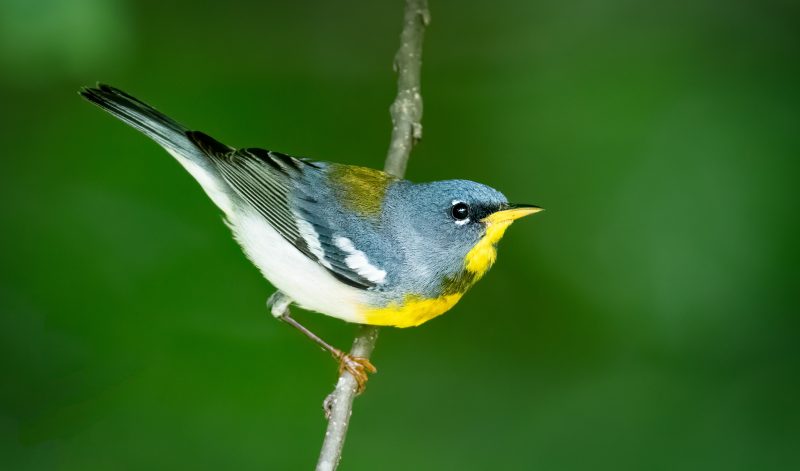
The Northern Parula is a small warbler characterized by its bright yellow chest and distinct white eye arcs that give it a unique facial pattern. Its back displays a subtle bluish-gray coloration, complemented by a greenish patch on the upper back. The combination of vibrant colors makes this bird easily recognizable during its active seasons.
In New Jersey, the Northern Parula is a migratory visitor, typically passing through during spring and fall. It favors habitats such as deciduous forests with plenty of moss and lichen, often near water bodies like streams and swamps. These birds are often heard before they are seen, thanks to their high-pitched buzzy songs.
Their diet mainly consists of insects and spiders which they glean from leaves and bark. Because of their preference for moist woodland areas, Northern Parulas play a role in controlling insect populations in these habitats as they migrate through the state.
Magnolia Warbler (Setophaga magnolia)
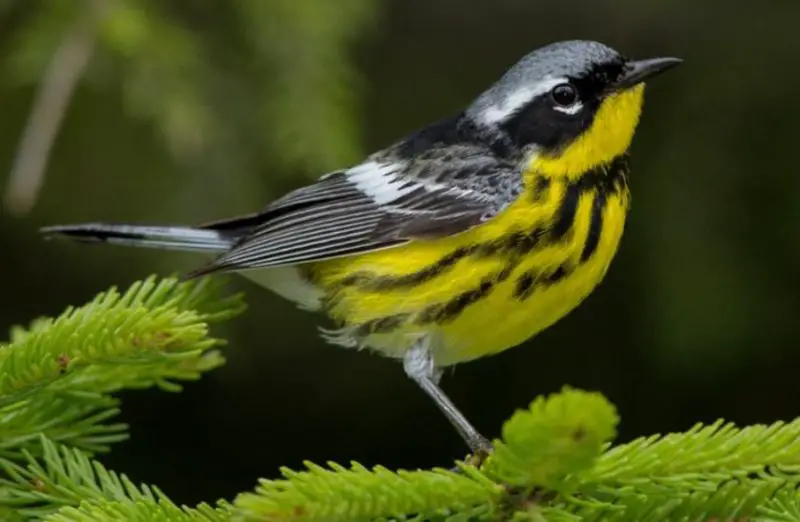
The Magnolia Warbler is notable for its bright yellow underparts contrasted by bold black streaks across its chest and sides. Its grayish back and white wing bars provide a striking contrast to its vivid belly, while its sharp facial markings add to its distinct appearance. The bird’s pattern is one of the most dramatic among warblers.
During migration periods in May and September, Magnolia Warblers are commonly observed in New Jersey. They prefer shrubby forests and woodland edges, especially areas with dense understory. Their active foraging behavior involves flitting through branches and picking insects from leaves.
Magnolia Warblers primarily feed on caterpillars, beetles, and other small arthropods. Their presence during migration highlights New Jersey’s importance as a stopover site for many long-distance songbirds. Birdwatchers often seek them out for their beautiful plumage and lively movements.
Blue-winged Warbler (Vermivora cyanoptera)
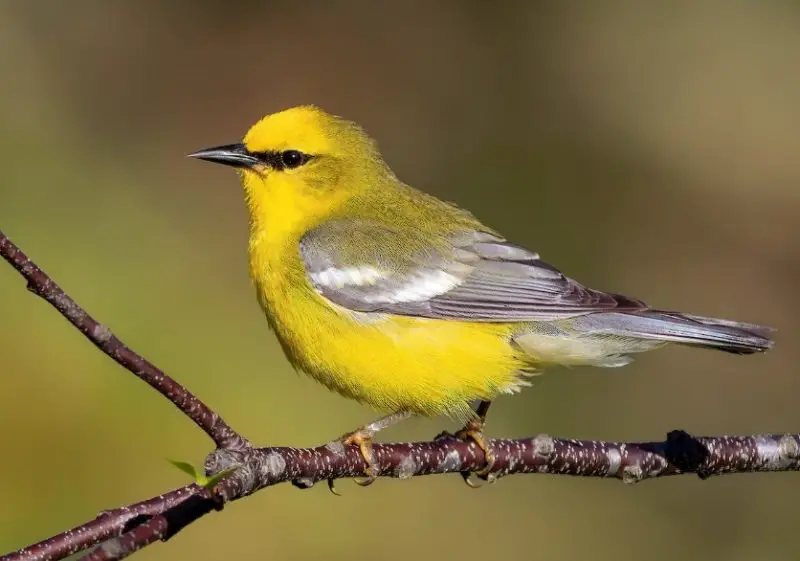
The Blue-winged Warbler is recognized by its bright yellow body combined with pale blue-gray wings and tail. A striking black line runs through its eye, enhancing its facial features and setting it apart from other yellow warblers. This combination of colors gives it a fresh, springtime look.
In New Jersey, Blue-winged Warblers arrive in the summer to breed, preferring habitats such as shrubby fields, young forests, and areas with dense brush. They build cup-shaped nests low to the ground or in thick vegetation, often hidden among tangled branches. Their breeding territories are actively defended through song.
Their diet is largely insectivorous, feeding on caterpillars, flies, and beetles, which they glean from foliage. The Blue-winged Warbler plays a vital ecological role in controlling insect populations in its breeding habitats across New Jersey during the warmer months.
Canada Warbler (Cardellina canadensis)
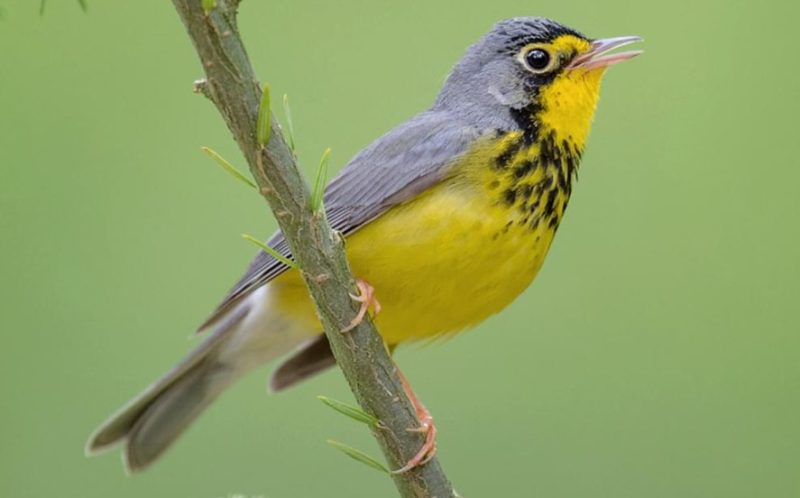
The Canada Warbler is a medium-sized warbler notable for its bright yellow chest and a distinctive black “necklace” of streaks around its throat, resembling a string of beads. Its grayish head contrasts sharply with its vibrant underparts, and its eyes are dark and expressive.
This species is a late migrant in New Jersey, generally passing through in late spring. It prefers dense, moist forest understories with thick shrubs, often near streams or swampy areas. Because it is shy and secretive, the Canada Warbler is more often heard singing its buzzy song than easily spotted.
Canada Warblers feed on a variety of insects and spiders, foraging low in dense vegetation. Their late migration and habitat preferences make them an important indicator species for healthy forest ecosystems in New Jersey during the breeding season.
Cape May Warbler (Setophaga tigrina)
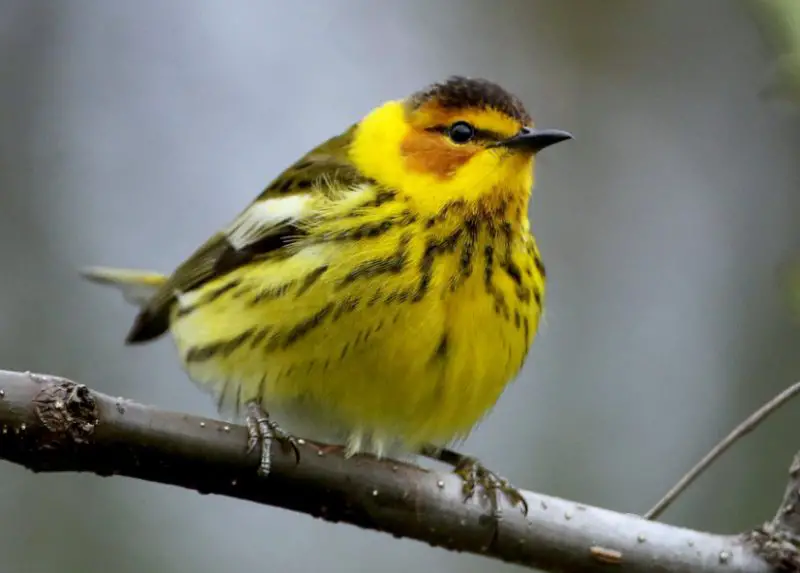
The Cape May Warbler is a striking warbler with a yellow-orange throat and heavily streaked yellow chest. Its face features a reddish-brown eye ring, while its back and wings are olive with hints of black and white wing bars. This bird’s bold markings make it quite distinctive among warblers.
In New Jersey, the Cape May Warbler is a migratory species that appears in spring and fall. It favors coniferous and mixed forests during migration and occasionally breeds in northern New Jersey in suitable habitats. Their presence is most notable during migration stopovers.
Their diet consists largely of spruce budworms and other caterpillars, which they expertly forage from conifer needles. This specialization allows Cape May Warblers to thrive during outbreaks of these insects, making them important in forest pest control during migration.
Common Yellowthroat (Geothlypis trichas)
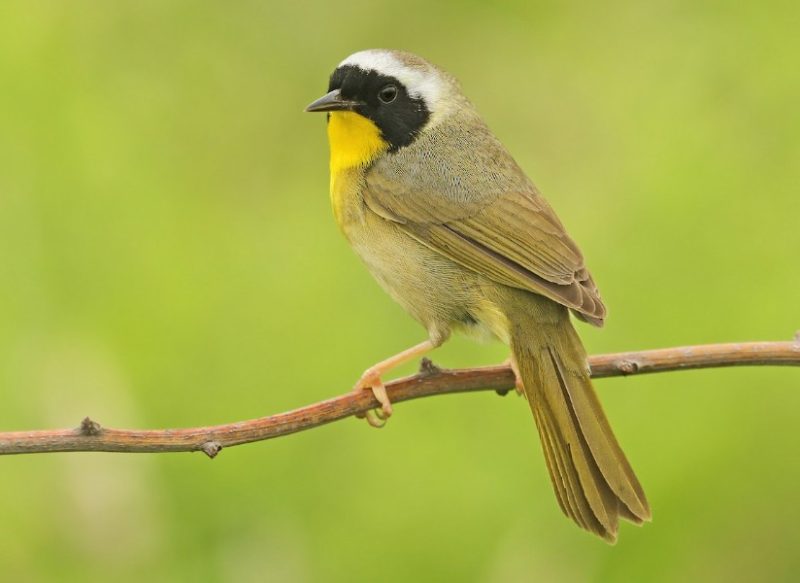
The Common Yellowthroat is a small, bright yellow bird with a distinctive black mask across the male’s face, bordered by a white or grayish line. Females lack the mask and are more uniformly yellow-green on top. Their olive backs and yellow throats make them easy to spot in dense vegetation.
This warbler is very common in New Jersey during spring and summer, especially in wetlands, marshes, and thick brushy areas. They prefer habitats with dense low vegetation, such as cattails, reeds, and shrubs near water. Their lively, rhythmic “witchety-witchety-witchety” song is a frequent sound in these environments.
Common Yellowthroats primarily feed on insects, spiders, and other small invertebrates, foraging close to the ground or within thick foliage. Their adaptability to wetland habitats makes them an important insect predator in New Jersey’s marsh ecosystems.
Evening Grosbeak (Coccothraustes vespertinus)
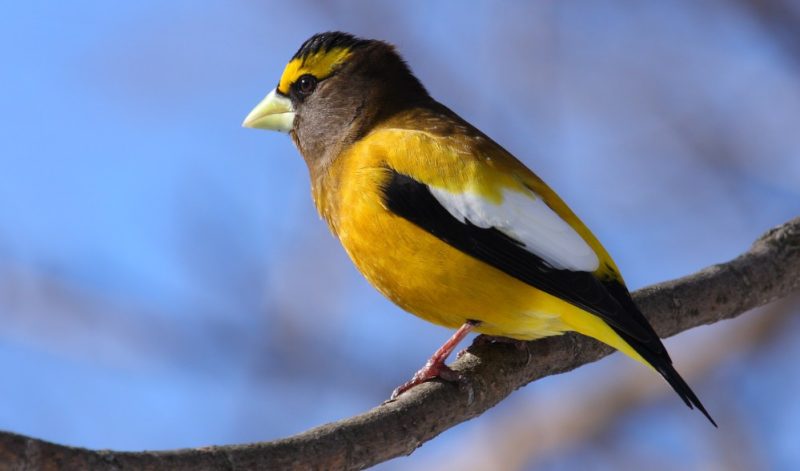
The Evening Grosbeak is a large, heavy-bodied finch with striking yellow and black plumage. Males exhibit bright yellow bodies with black wings and a large, pale bluish bill, while females are more muted but similarly patterned. Their robust bills are well adapted for cracking seeds and nuts.
This species is very rare in New Jersey, occasionally appearing in the winter months when irruptive movements occur due to food shortages farther north. When present, Evening Grosbeaks are often found in forests and suburban areas with abundant seed sources.
Evening Grosbeaks feed mainly on seeds, berries, and insects. Their strong bills allow them to open tough seeds like those of maples and ashes. Though uncommon, their occasional visits to New Jersey delight birdwatchers with their bold coloration and large size.
Pine Warbler (Setophaga pinus)
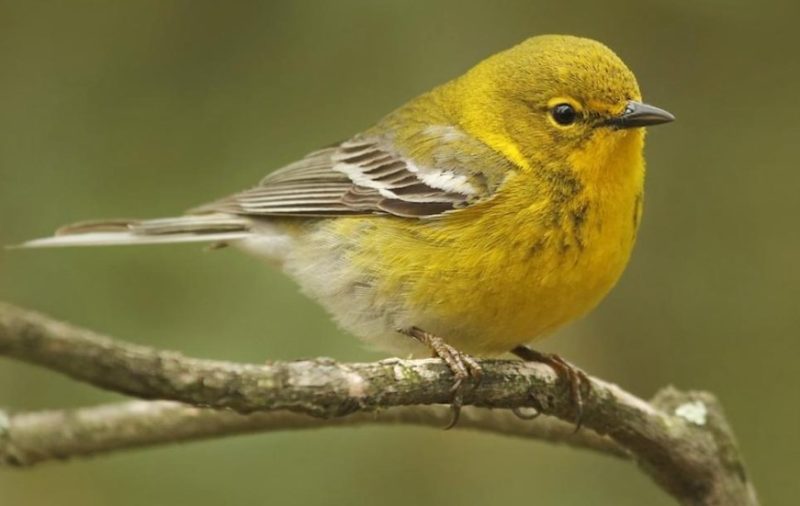
The Pine Warbler is a medium-sized warbler with an overall olive-yellow coloration. Males are brighter with yellow-green upperparts and yellow underparts, while females and juveniles appear duller and more subdued. This species is one of the few warblers that can be found year-round in New Jersey.
Pine Warblers prefer pine forests, where they forage high in the canopy searching for insects and seeds. They often visit bird feeders during winter, especially if sunflower seeds are offered. Their slow, buzzing trill is a typical sound in pine woods throughout the year.
Their diet consists mainly of insects and spiders during the breeding season, supplemented by seeds and berries in winter. Pine Warblers’ ability to thrive in coniferous habitats helps them maintain stable populations in New Jersey’s pine forests.
Prairie Warbler (Setophaga discolor)
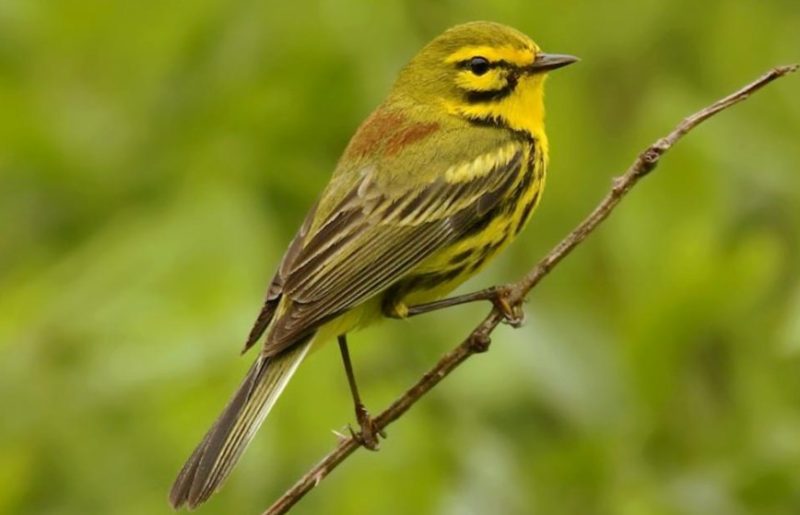
The Prairie Warbler is easily recognized by its bright yellow body marked with black streaks along the sides of the chest and a distinctive black curved line on the face. The back is olive-green, and the overall plumage is vivid and eye-catching.
In New Jersey, Prairie Warblers breed in open woodlands, shrubby fields, and early successional habitats where trees are sparse. They prefer areas with scattered bushes and young trees, often in sandy or dry soils. This habitat choice makes them sensitive to changes in land use.
Prairie Warblers primarily consume insects such as caterpillars and beetles. Their song is a rising series of buzzy notes that sound like “zee-zee-zee-zoo-zee.” They are an important indicator species for healthy, regenerating habitats in New Jersey.
Wilson’s Warbler (Cardellina pusilla)
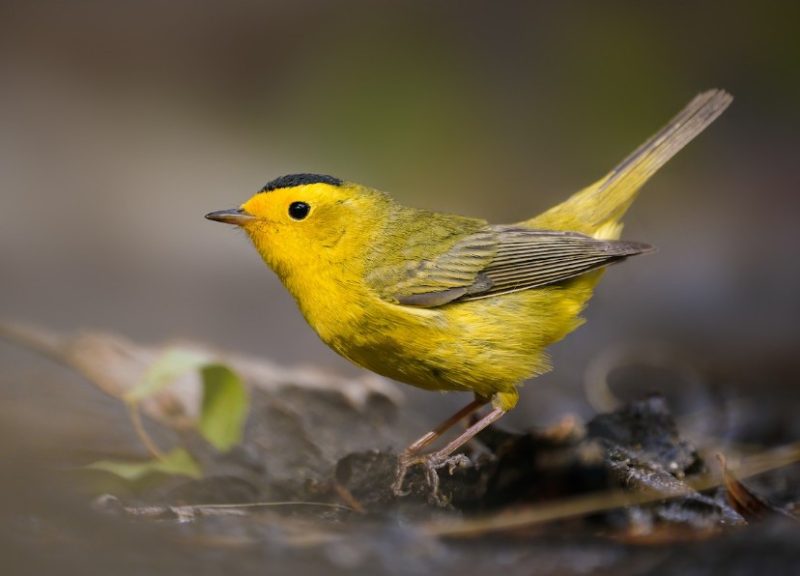
Wilson’s Warbler is a small, bright yellow warbler with a distinctive black cap on the male’s head, while females have a duller head without the cap. Their slender bodies and sharp features help distinguish them from other yellow warblers.
This species is rare in New Jersey but can be seen during spring and fall migration in city parks and wooded areas. Wilson’s Warblers prefer moist thickets and riparian habitats during migration, where they rest and refuel before continuing their journey.
They feed mostly on insects, gleaned from foliage and branches. Despite their small size, Wilson’s Warblers are energetic and vocal, producing a high-pitched, rapid song. Their rarity in New Jersey makes them a special sighting for local birders.
Hooded Warbler (Setophaga citrina)
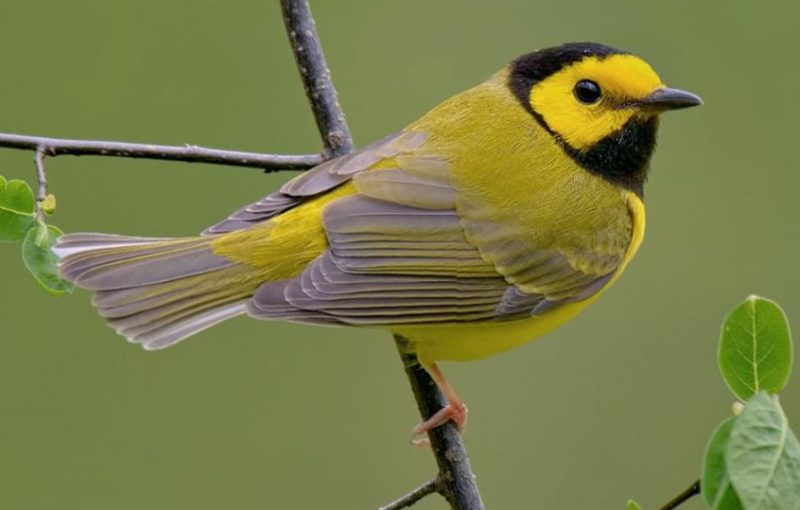
The Hooded Warbler is a striking warbler with a bright yellow body contrasted by a bold black hood covering its face and neck, resembling a hooded cloak. The sharp contrast between the yellow and black makes it easily identifiable among other warblers. Females and juveniles have less distinct markings but still show yellow underparts.
In New Jersey, Hooded Warblers appear during the summer months, favoring dense, deciduous forests with thick undergrowth. They often inhabit woodland edges and shaded forest interiors where they can forage and nest safely. Their presence is usually marked by their clear, ringing song.
This species feeds mainly on insects and spiders, which it gleans from leaves and low branches. Hooded Warblers are territorial during breeding season, and their vivid coloration and distinctive calls make them a favorite for birdwatchers exploring New Jersey’s forest habitats.
Yellow-throated Vireo (Vireo flavifrons)
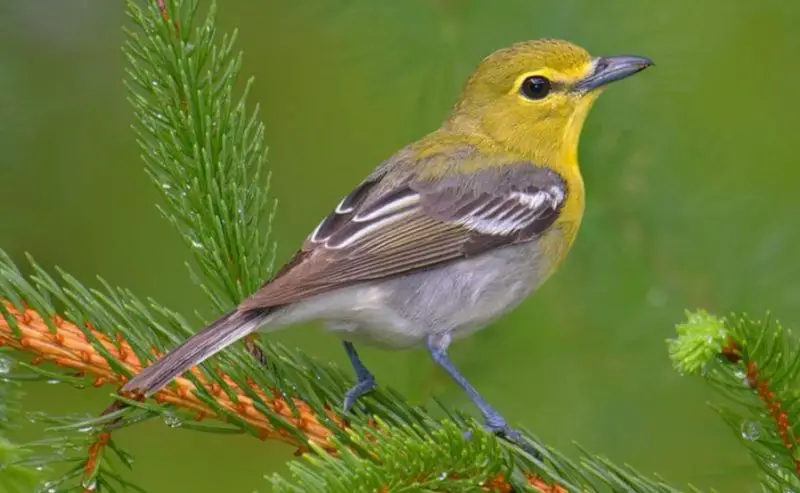
The Yellow-throated Vireo is a medium-sized songbird recognized by its bright yellow throat and underparts, complemented by a grayish head and two bold white wing bars. Its white eye ring and subtle facial markings add to its distinct appearance, making it stand out among vireos.
Commonly found in New Jersey during spring and summer, this bird prefers mature deciduous and mixed forests. It frequents wooded areas near streams or moist habitats where insects are plentiful. The Yellow-throated Vireo has a slow, deliberate song often described as a soft, descending whistle.
Its diet consists mostly of caterpillars, beetles, and other insects, which it picks from foliage while perched or hovering. This vireo plays an important role in controlling insect populations in forest ecosystems throughout its breeding range in New Jersey.
Yellow-throated Warbler (Setophaga dominica)
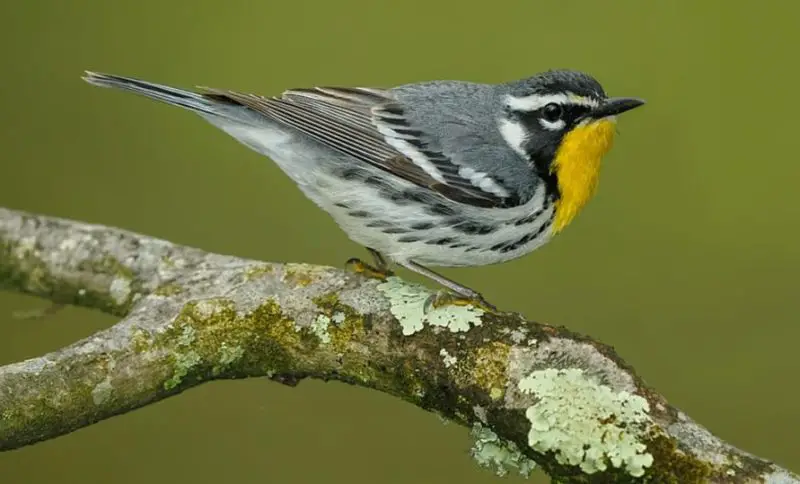
The Yellow-throated Warbler is easily identifiable by its vibrant yellow throat and white chest, contrasted with a black head that features white cheek patches. This striking coloration and its sharp, pointed bill set it apart from other warblers in New Jersey.
Though less common, Yellow-throated Warblers are present in the state during spring and summer. They favor mature pine forests, mixed woodlands, and riverine habitats where tall trees provide ample nesting sites. Their song is a clear, descending series of notes that carries well through forested areas.
These warblers primarily feed on insects such as caterpillars and spiders, foraging high in the canopy. Their specialized habitat preferences and distinctive calls make them a prized find for birdwatchers in New Jersey during the breeding season.
Nashville Warbler (Leiothlypis ruficapilla)
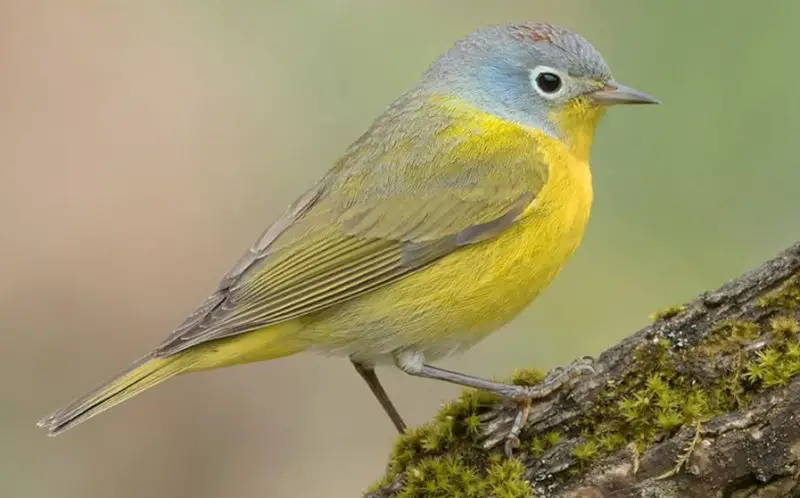
The Nashville Warbler is a small songbird with a soft yellow chest and gray head, featuring a conspicuous white eye ring that encircles dark eyes. This combination of colors makes the bird fairly easy to recognize despite its modest size.
In New Jersey, Nashville Warblers are migratory and typically pass through during spring and fall. They prefer deciduous woodlands and shrubby habitats, often foraging low in the understory. Their presence in the state is usually brief as they continue their longer migrations north or south.
Their diet mainly consists of insects, including caterpillars and flies, which they glean from leaves and branches. Nashville Warblers contribute to insect control and are appreciated for their gentle songs and colorful appearance during migration stopovers.
Orange-crowned Warbler (Leiothlypis celata)
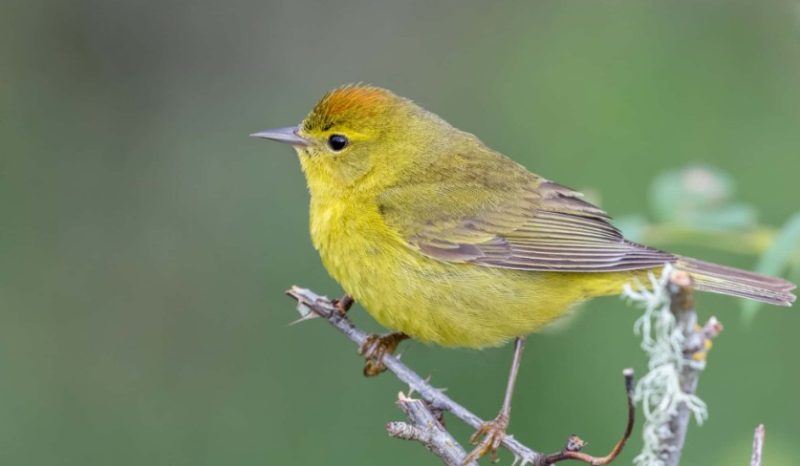
The Orange-crowned Warbler is a subtle and often overlooked bird with olive-yellow plumage and a faint orange patch on the crown, which can be difficult to see. Unlike many brightly colored warblers, this species blends well with foliage, making identification a bit challenging.
This warbler is rare in New Jersey and is mostly observed during fall migration. It inhabits a variety of habitats including open woodlands, shrubby fields, and brushy areas. Despite its muted colors, it can be identified by its thin, insect-like song.
Feeding primarily on insects and spiders, the Orange-crowned Warbler gleans prey from leaves and twigs. Its elusive nature and rarity in the state make it a special sighting for bird enthusiasts in New Jersey.
Kentucky Warbler (Geothlypis formosa)
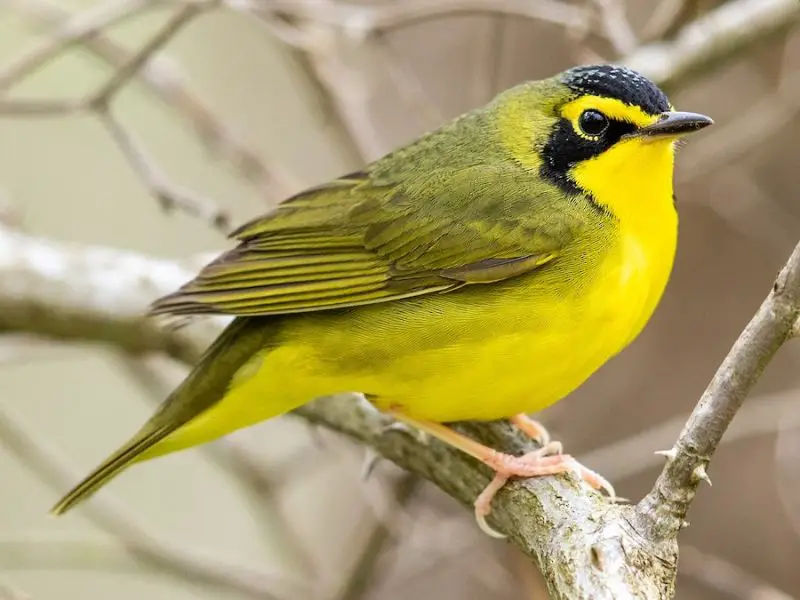
The Kentucky Warbler has a bright yellow belly and throat, contrasted with a black crown and a distinctive black mask running through the eyes. Its olive-green back and rounded body shape add to its unique appearance among wood warblers.
In New Jersey, this species is uncommon and prefers moist deciduous forests with dense understory vegetation. It tends to stay close to the ground, often hidden within thick leaf litter or dense bushes. Kentucky Warblers are most often detected by their loud, ringing song rather than visual sightings.
Their diet consists mainly of insects and other small invertebrates found in the leaf litter. Due to their preference for dense, moist habitats, Kentucky Warblers are sensitive to habitat changes but remain a valued species in New Jersey’s forest bird community.
FAQs About Yellow Birds in New Jersey
What are some common yellow birds found in New Jersey?
New Jersey is home to several yellow bird species, including the American Goldfinch, Yellow Warbler, Yellow-rumped Warbler, and Common Yellowthroat. These birds can be seen in a variety of habitats such as forests, wetlands, and backyard gardens throughout different seasons.
When is the best time to see yellow warblers in New Jersey?
Yellow warblers, including species like the Yellow Warbler and Magnolia Warbler, are most commonly seen during spring and summer. These birds migrate through New Jersey in the spring on their way to breeding grounds and return south in the fall, making migration seasons ideal for spotting them.
Do yellow birds in New Jersey stay year-round or are they migratory?
Some yellow birds like the American Goldfinch and Pine Warbler can be found year-round in New Jersey. Others, such as the Yellow Warbler, Magnolia Warbler, and Cape May Warbler, are migratory and are present mainly during spring and fall migration periods or summer breeding seasons.
What habitats do yellow birds prefer in New Jersey?
Yellow birds inhabit diverse environments depending on the species. For example, the American Goldfinch prefers open fields and gardens, Yellow Warblers favor shrubby wetlands, while Hooded Warblers are found in dense deciduous forests. Wetlands, forests, and brushy areas are common habitats for many yellow birds.
What do yellow birds in New Jersey typically eat?
Yellow birds’ diets mainly consist of insects, spiders, and seeds. Species like warblers often feed on caterpillars and other small insects, while finches such as the American Goldfinch primarily consume seeds like nyjer and sunflower seeds.
How can I attract yellow birds to my backyard in New Jersey?
To attract yellow birds like American Goldfinches and warblers, provide native plants that produce seeds and berries, offer feeders stocked with nyjer and sunflower seeds, and maintain shrubs or brush piles for shelter. Having water sources and minimizing pesticide use also helps create a bird-friendly environment.
Are any yellow birds in New Jersey considered rare or threatened?
Yes, some species like the Prothonotary Warbler and Kentucky Warbler are less common and considered rare in New Jersey due to their specific habitat needs and limited range. Conservation efforts focus on preserving wetlands and mature forests to support these populations.

